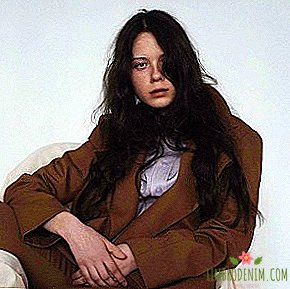Greenwatering: How brands and products pretend to be green
Today, more and more brands take a course on environmental friendliness, which is not surprising - initiatives like sorting garbage or going to the store with eco-bags have finally become the habit of many buyers. However, not all products that are positioned as "green" are really environmentally friendly - sometimes their manufacturers are limited to only loud statements. This phenomenon has been called greenwashing - we tell how it works and how to recognize it.
TEXT: Alisa Zagryadskaya

Marketing ploy
The ideals of environmental friendliness began to be talked about in the late sixties, when the production volumes of artificial materials increased, and fast fashion began to seize new territory. In the early seventies, the famous environmental organizations Greenpeace and Friends of the Earth, which questioned the idea that man is the king of nature. Along with new research, it was understood that concern for the environment is necessary in order not only to preserve the quality of life of people, but also to save other species.
The interest in preserving the environment has also affected the market for goods. The eco-friendly approach gradually began to spread: back in the sixties and seventies, consumers began to pay attention to organic products, although, of course, it was far from modern green marketing. In the eighties, several well-known "green" brands appeared, flourishing until now, including The Body Shop, Burt's Bees and Whole Foods.
Finally, in the nineties, eco-friendly brands gradually ceased to be an exceptionally niche story. "Green marketing", or ecomarketing, has appeared - the so-called promotion of eco-friendly products or brands. In an amicable way, such products should be environmentally friendly or created in an environmentally safe production. It should work without toxic or ozone-depleting substances and overpacking, and use recycled or renewable materials.
The more conscious consumption enters the fashion, the more actively manufacturers tend to show their involvement in the trend.
It turned out that many people are more willing to buy eco-products. According to a study conducted in 2014 by the analytical company Nielsen with the participation of people from sixty countries of the world, the majority of consumers are ready for eco-friendly products. About 55% of respondents were willing to pay more if the company pays attention to how its products affect society and the environment. And 52% at least once bought things of such brands over the past six months. More than half of the respondents reported that they checked the product packaging to see if it harmed the environment.
It would seem that the picture is blissful: consumers are ready to support environmental initiatives, and companies have a reason to make production more environmentally friendly. However, it is more difficult to implement such an approach than it seems: the corresponding production and marketing imply additional costs and efforts. It is necessary to change established processes, introduce development, reduce waste and emissions, obtain certificates, and also compete with "green" alternatives.
Some companies recognize the benefits of eco-marketing, but are not ready to invest in real change, preferring to limit themselves to green logo on the packaging and environmental slogans in advertising. The stronger the conscious consumption comes into vogue, the more actively the producers strive to show their involvement in the trend - even if behind loud words there is nothing. And the fact that the consumer is often unable or unwilling to figure out which product is really “green” only plays into their hands.

Green water
The term "green water" was introduced by the American ecologist Jay Westerveld. In 1986, he wrote an essay about how hotels offered to guests to use towels more than once and to abandon the daily replacement of bed linen. The owners of the establishments said that they wanted to reduce the damage to the environment in this way, however, Westerveld was sure that it was only a question of reducing costs. The appeal, outraged by Westerveld, referred to the salvation of coral reefs and oceans, however, in his opinion, the establishment could have caused environmental damage in other ways.
Greenwrestling itself appeared much earlier than the term - at a time when television advertising controlled public moods. For example, a video with a "weeping Indian", created in the early seventies by the non-profit organization Keep America Beautiful with the participation of the American Advertising Council. In the story, the Native American, getting out of the canoe, sees the ground covered with garbage and drops a tear. The campaign’s slogan is “People started pollution. People can stop it.” The video became one of the most famous social advertisements in the world and hit the hundred best campaigns of the 20th century according to Ad Age magazine.
The cynicism of the situation is that behind Keep America Beautiful stood leading companies - manufacturers of beverages in disposable containers - among them, for example, Coca-Cola. At the same time, corporate participation in Keep America Beautiful was not emphasized - the organization looked like a neutral third party. In The Land of Trash, journalist Elizabeth Royt calls Keep America Beautiful's work "a masterful example of green-waving." At first glance, the famous movie has a completely correct message: no need to litter. At the same time, he entirely shifts the responsibility to the buyer, while the companies continue to produce and sell disposable packaging. Everything else, Iron Eyes Cody, who played in advertising, was not an American Native, but an actor of American-Italian origin.
Statements of companies must be supported by evidence, and a lie can turn into not only criticism in the press, but also lawsuits
Chevron, an oil company, organized another famous green-waving campaign in the eighties. She launched the "People Do" series of videos - the beauty of nature illustrated the statement that Chevron seeks to leave everything intact. The campaign turned out spectacular and even received an Effie award - while Chevron illegally dumped waste in the habitats of wild animals. The company did organize environmental programs, which it loudly stated, for example, by restoring oil production sites, although it was silent that some of these measures were prescribed by law. Joshua Karliner, author of Planet of Corporations, estimates that Chevron spends only five thousand dollars a year on a program to protect butterflies, which still exists today, while producing and promoting advertising costs hundreds of thousands.
Similarly, the chemical company DuPont, in 1991 timed to the release of double-hull oil tankers commercial video with marine animals. It would seem, how can a company, in the video of which sea lions so touchingly clap their flippers, and the otters whirl in the water under Beethoven's “Joy” ode, to harm nature? However, according to a report from the organization Friends of the Earth, that same year, DuPont turned out to be the largest source of pollution among all US corporations.
The production and sale of bottled water is another clear example of green watering. In advertising such products often appear landscapes of pristine highlands, clear lakes and ice springs. This is also indicated by the names of the brands, even Russian ones - for example, the "Sacred source". Companies spend millions to create the feeling that their product is part of nature. For example, Nestlé in zero decided to promote its plastic bottles as more environmentally friendly, and in Canadian advertising called bottled water "the most environmentally responsible consumer product in the world."
The latter has caused dissatisfaction with local eco-organizations, which complained about unfair advertising. According to environmentalists, in principle, a plastic bottle cannot be an eco-friendly option, the safest thing for nature is to drink water from a reusable bottle. But the International Association of Bottled Water Producers states that bottled water is “a sign of positive change,” since the industry now uses less non-recyclable plastic. Nestlé, for example, rests on the fact that their bottles can be completely recycled - and the trace of using bottled water is only a small part of the carbon footprint of the average buyer.
Today, the word "greenhousing" is being used more and more often - it even entered into the electronic version of the Oxford English Dictionary. It becomes clear that the allegations of companies must be supported by evidence, and a lie can turn into not only criticism in the press and protests of activists, but also lawsuits. For example, not so long ago, Walmart paid a million dollars to settle claims to the sale of "eco-friendly" biodegradable plastic. California law prohibits selling plastic containers labeled "biodegradable" if it misleads customers - namely, if the manufacturer does not specify how exactly and how long the material will decompose.

Where is the truth
According to recent studies, most often, buyers who are concerned about the impact on the environment, are looking for more environmentally friendly products among cleaning products, cosmetics and food. Fortunately, today there are more and more opportunities to check what really stands behind loud statements. According to the site of The Sins of Greenwashing, owned by UL, a company testing and certifying products, in 2010, 73% more goods appeared on the market, positioned as eco-friendly than in 2009. Most of the Greenwoshes are in the areas of office products, health and beauty, detergents and household goods, followed by electronics and toys.
And although almost ten years have passed since the publication of this data, today green marketing is definitely more common. For example, from 2010 to 2015, the global market for organic products increased from 57 to 105 billion dollars.
The same UL company has formulated the "sins of greenwalking" - a list of signs by which one can understand that the brand is really only covered by slogans. Among them, for example, a hidden compromise: the product is called "environmentally friendly" because of one useful quality, while other harmful factors are hushed up. So, paper can be produced from ethically collected wood, which does not eliminate the harm from other resources and associated emissions.
Among other signs of green-waving are unsubstantiated or abstract statements. For example, "completely natural": say, arsenic, uranium, mercury and formaldehyde are found in nature and are completely natural, and also - poisonous. There are also irrelevant statements: the brand proudly reports that it does not include a substance that is already prohibited by law, or calls itself "advanced" because it complies with mandatory regulations. There are also less obvious situations, for example, the lesser of two evils. Products are positioned as less harmful, but belong to a category that is known to be dangerous for the environment.
The words "eco", "natural", emphasized "eco-friendly" packaging, marketing flirting with herbs and nature in themselves do not guarantee anything
In fact, Greenvoshing is found in almost all areas - from building materials (for example, eco-paint or eco-parquet made from natural materials, where the manufacturer is silent about the substances binding them and the origin of raw materials) to products labeled "bio" without any certificates. The words "eco", "natural", emphasized "eco-friendly" packaging (for example, craft paper), marketing flirting with herbs and nature ("from the very heart of the Murom forests") and other vague promises of the manufacturer by themselves do not guarantee anything.
Yulia Gracheva, Ph.D. in Biology and the head of the Leaf Life certification body, says: “The method of evaluating [such statements] should be clear, transparent, scientifically sound and documented. This will allow buyers to be confident in their authenticity. Any statement must be supported document or test report. It doesn’t matter if there is a label on the label “products are environmentally friendly” or “green”. " According to her, according to this standard, it is impossible to use general formulations - “non-polluting”, “environmentally friendly” and so on: the laws do not control what is behind these words. "Statements must be clear, for example," without powdered milk, "" without dyes, "" without food additives, "but at the same time relevant," notes Gracheva.
Greenwatering is not always the result of a cunning plan and customer fraud - sometimes it’s just excessive marketers' enthusiasm. This is how incidents like “non-GMO soda” appear - manufacturers forget not only that the harm of genetically modified products has not been proven, but also that soda, in principle, cannot be genetically modified. In order to distinguish the real eco-product from the fake one, you need to pay attention to the markings - we told them in detail here. The Ecopolis project has released the free Ecolabel Guide application, which recognizes real eco-labels on product packaging.
In international practice, there is an organic standard set by the International Federation of Organic Agriculture, and ISO 14024, which assesses the entire process of product existence from the point of view of how it affects the environment. In the world there are many organizations that issue a certificate of organic products, focusing on these installations. Russia introduced GOST 56508-2015, which defines what organic products are and how they should be produced, transported and stored, as well as GOST R 57022-2016, which controls how such goods are given certificates. According to Yulia Gracheva, there is a “mess” with certification: there are a lot of companies that carry it out, their standards can vary, and their actions are still under control.
PHOTO:Leonid - stock.adobe.com




